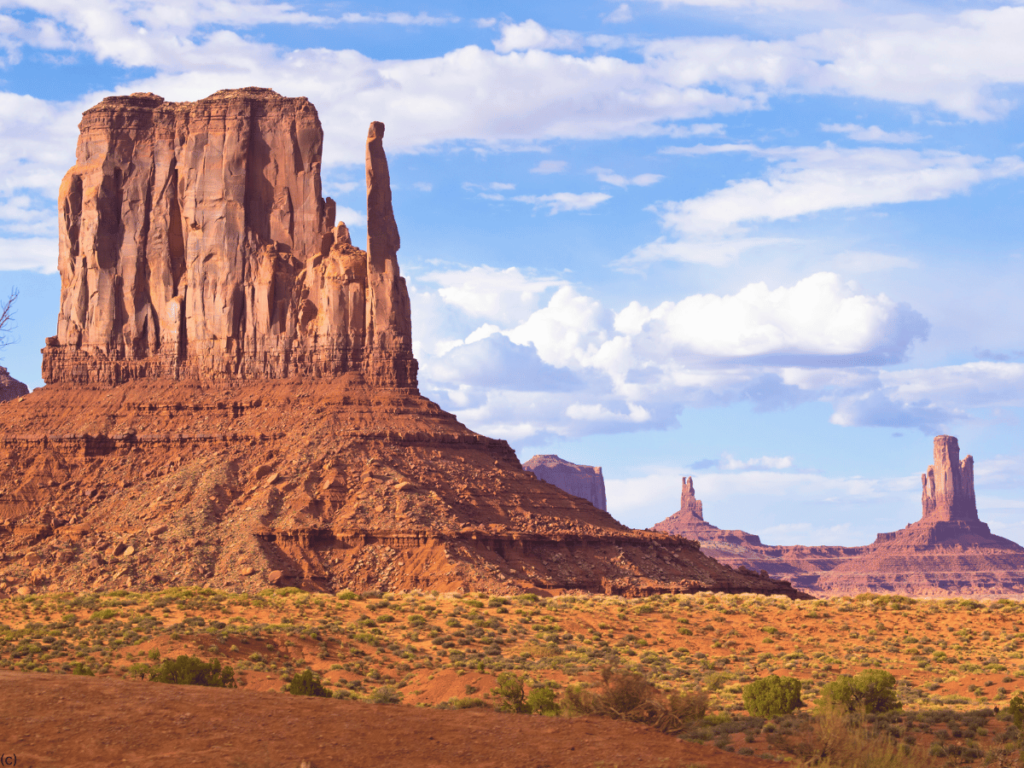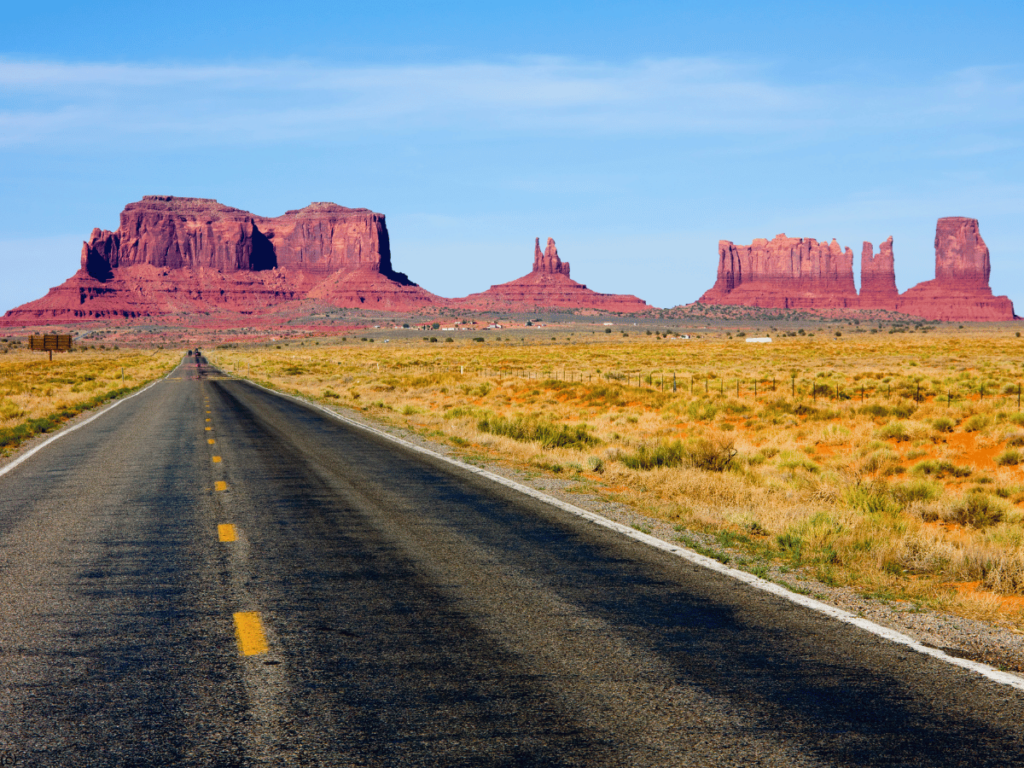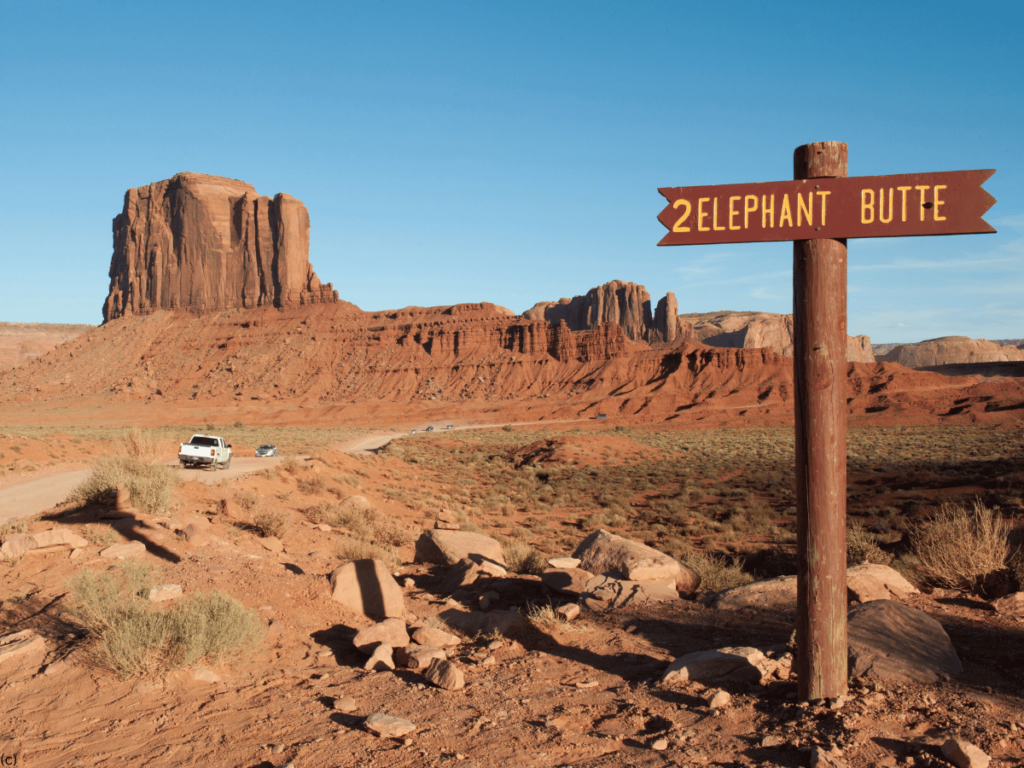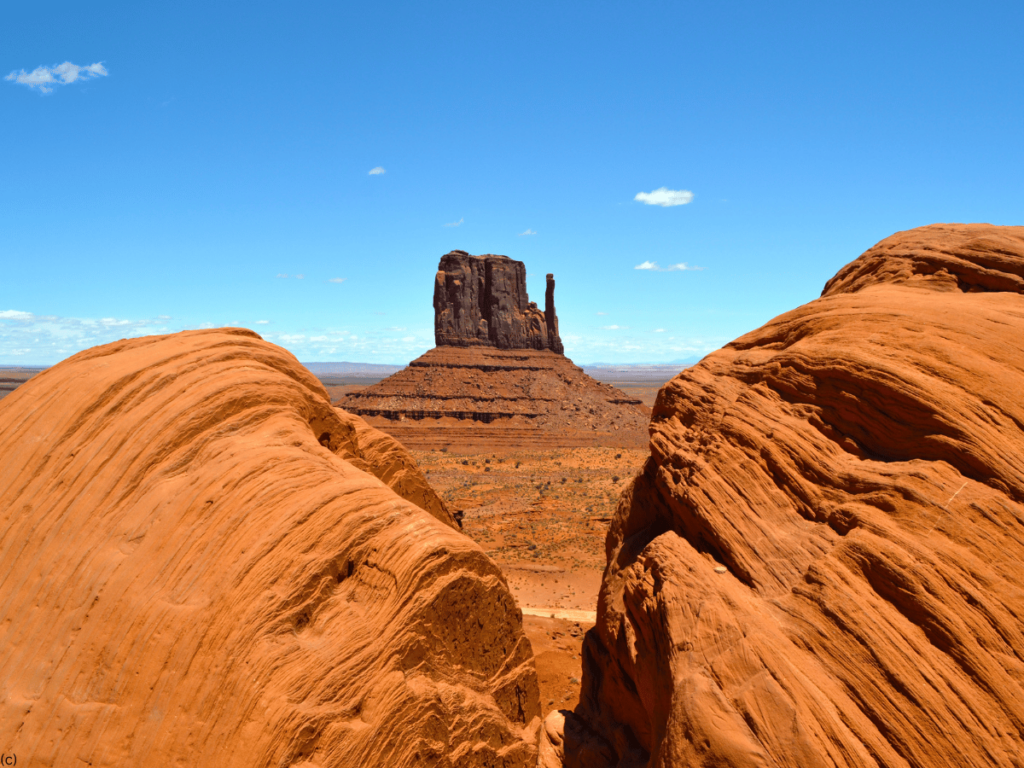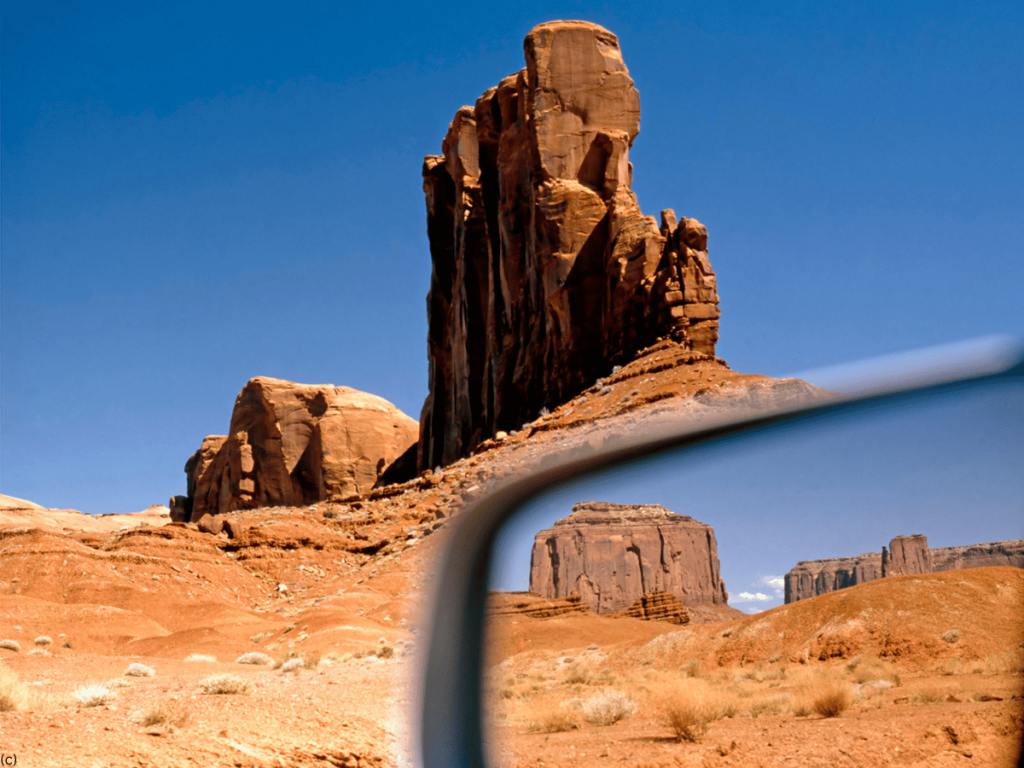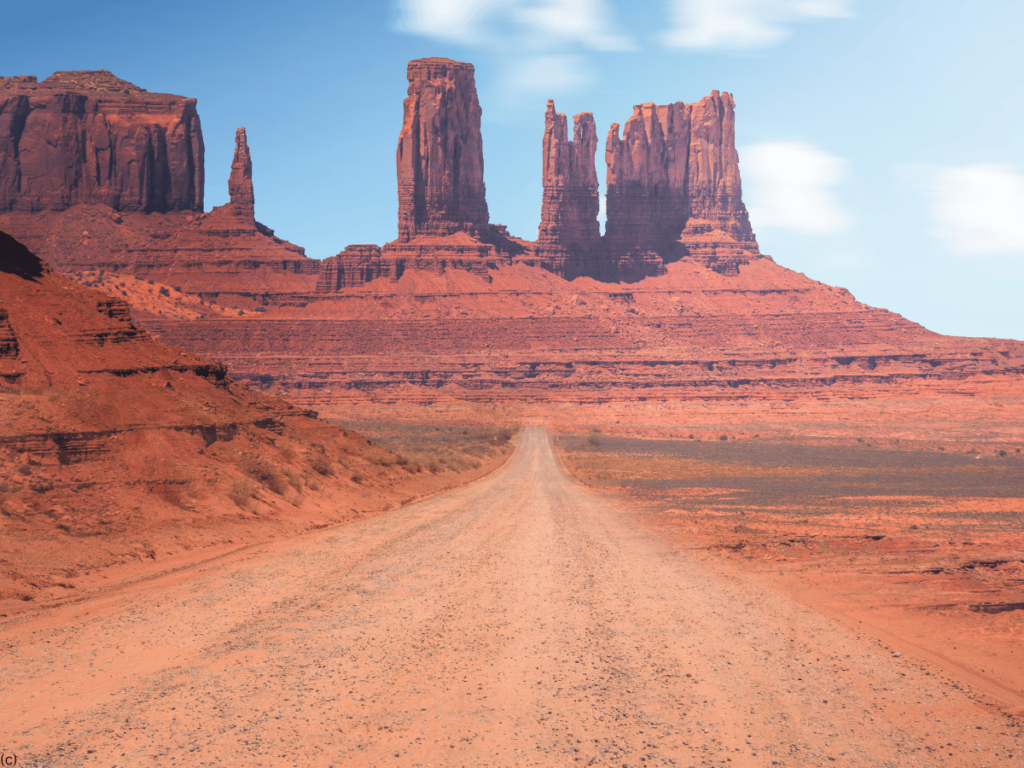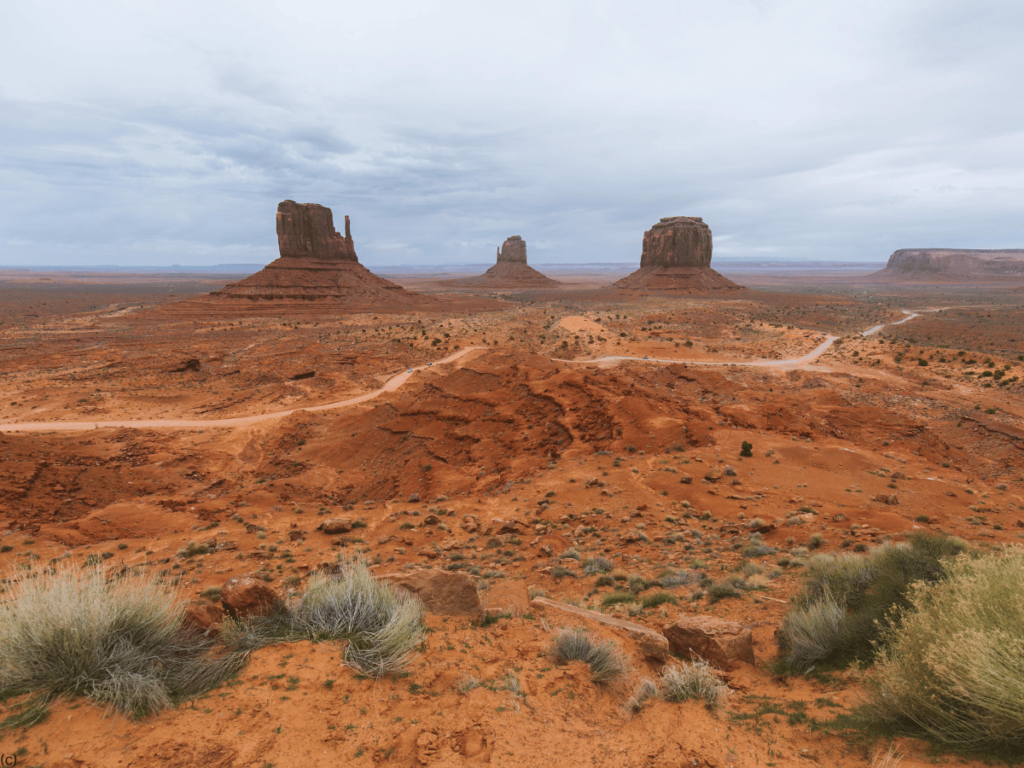
Monument Valley is more than just a stunning landscape; it’s a symbol of the American West. Straddling the border between Arizona and Utah, this iconic region has been the backdrop for countless films, photographs, and cultural representations. The towering sandstone buttes and mesas, shaped by millions of years of erosion, rise majestically from the desert floor, creating a scene that feels both timeless and otherworldly.
For centuries, Monument Valley has been home to the Navajo Nation, whose culture and traditions are deeply intertwined with the land. Today, Monument Valley Navajo Tribal Park, the heart of this sacred landscape, offers visitors a chance to experience the beauty, history, and spirituality of this extraordinary place. Whether you’re a photographer, a history buff, or simply someone who appreciates natural beauty, Monument Valley is a must-see destination that captures the essence of the American Southwest.
The Geological Marvel of Monument Valley
Monument Valley’s landscape is dominated by vast, open spaces punctuated by massive sandstone formations that rise abruptly from the desert floor. These formations, known as buttes, mesas, and spires, were formed over millions of years through processes of deposition, uplift, and erosion.
Formation and Evolution
The story of Monument Valley’s formation begins over 250 million years ago during the Permian period when the region was covered by a shallow sea. Over time, layers of sand, silt, and other sediments were deposited and compacted into rock. As the sea receded, these layers were gradually uplifted by tectonic forces, forming a vast plateau.
Over millions of years, wind and water erosion began to sculpt the plateau, wearing away the softer rock layers and leaving behind the harder sandstone formations. The towering buttes and mesas that we see today are remnants of this once-continuous plateau, shaped by the relentless forces of nature.
The most famous formations in Monument Valley include the Mittens, two towering buttes with distinctive “thumb” projections, and the Totem Pole, a slender spire that stands as a testament to the power of erosion. These formations, with their dramatic shapes and vivid red hues, have become symbols of the American Southwest.
The Colors of Monument Valley
One of the most striking features of Monument Valley is its vibrant color palette. The deep reds and oranges of the rock formations are the result of iron oxide (rust) in the sandstone, while the occasional green or blue tints come from other minerals, such as copper. These colors are particularly vivid at sunrise and sunset, when the low-angle light enhances the contrast and depth of the landscape.
The valley floor, covered with red sand and scattered vegetation, adds to the visual richness of the scene. The stark contrast between the dark shadows of the buttes and the bright desert floor creates a dynamic and ever-changing landscape that never fails to captivate visitors.
The Cultural Significance of Monument Valley
While Monument Valley is often celebrated for its natural beauty, it is also a place of deep cultural and spiritual significance for the Navajo people. The Navajo, who refer to Monument Valley as “Tsé Biiʼ Ndzisgaii” (Valley of the Rocks), have lived in and around the valley for centuries. For them, the land is not just a backdrop but a living, breathing entity imbued with spiritual meaning.
Navajo Nation and Monument Valley
Monument Valley lies within the Navajo Nation, the largest Native American reservation in the United States. The Navajo people have a profound connection to the land, viewing it as a sacred space that is integral to their cultural identity and spiritual practices. Many of the formations in Monument Valley are associated with Navajo legends and are considered to be the homes of spiritual beings.
For the Navajo, the land is a source of sustenance, both physical and spiritual. The traditional Navajo lifestyle is deeply rooted in the natural world, with practices such as farming, weaving, and ceremonies that honor the land and its spirits. Monument Valley, with its dramatic landscape, plays a central role in Navajo cosmology, serving as the setting for many of the stories and teachings that have been passed down through generations.
The Navajo Language and Storytelling
The Navajo language, or Diné Bizaad, is one of the most complex and poetic languages in the world. It is a language that is rich in metaphor and deeply connected to the land. Many of the names for the formations in Monument Valley are descriptive and symbolic, reflecting the Navajo people’s relationship with their environment.
Storytelling is a vital part of Navajo culture, and many of the stories revolve around the land and its features. For example, the formation known as “Yei Bi Chei” represents the Navajo Holy People, who play a central role in Navajo ceremonies and healing practices. The stories associated with these formations are not just entertainment but are considered essential for understanding Navajo history, values, and beliefs.
Monument Valley in Popular Culture
Monument Valley has become one of the most recognizable landscapes in the world, thanks in large part to its frequent appearance in films, television shows, and other forms of popular culture. Its dramatic scenery and distinctive formations have made it a favorite location for filmmakers and artists, contributing to its iconic status.
Hollywood and the Western Genre
Monument Valley’s association with Hollywood began in the 1930s when director John Ford chose the valley as the backdrop for several of his Western films. Ford’s 1939 film Stagecoach, starring John Wayne, was the first major motion picture to be filmed in Monument Valley and is credited with popularizing the landscape as a symbol of the American West.
Over the years, Monument Valley has appeared in numerous Westerns, including classics such as The Searchers (1956) and She Wore a Yellow Ribbon (1949). These films helped to cement the image of Monument Valley as the quintessential Western landscape, embodying the rugged, untamed spirit of the frontier.
The influence of these films extends beyond the Western genre. Monument Valley has also appeared in science fiction films such as 2001: A Space Odyssey (1968), where it was used to represent the alien landscape of another world. Its iconic formations have even been featured in animated films like Cars (2006), introducing a new generation to the beauty of the valley.
Monument Valley in Photography and Art
In addition to its role in film, Monument Valley has been a favorite subject for photographers and artists. The landscape’s striking contrasts, dramatic light, and vivid colors make it a compelling subject for creative expression.
Photographers such as Ansel Adams and Edward Weston have captured the beauty of Monument Valley in black-and-white images that emphasize the stark, sculptural quality of the landscape. These images have become iconic representations of the American West and have helped to raise awareness of the need to preserve these natural wonders.
Contemporary artists continue to be inspired by Monument Valley, using various mediums to interpret the landscape in new and innovative ways. The valley’s enduring appeal lies in its ability to evoke a sense of timelessness and mystery, qualities that resonate with both artists and viewers alike.
Exploring Monument Valley: Things to Do
Visiting Monument Valley is a unique experience that offers a range of activities, from guided tours and hiking to cultural experiences and photography. Whether you’re seeking adventure or a deeper connection with the land, there’s something for everyone in this extraordinary landscape.
Guided Tours
One of the best ways to explore Monument Valley is by taking a guided tour led by a Navajo guide. These tours provide insight into the cultural and spiritual significance of the land, as well as access to areas that are not open to the general public.
- Jeep Tours: These are the most popular tours in Monument Valley, taking visitors on a journey through the valley’s most famous formations. The tours typically last two to three hours and include stops at iconic locations such as the Mittens, John Ford’s Point, and the Totem Pole. Along the way, guides share stories and legends associated with the land, offering a deeper understanding of its significance to the Navajo people.
- Photography Tours: For photographers, special tours are available that focus on capturing the perfect shot. These tours often take place at sunrise or sunset when the light is most dramatic. Guides can help photographers find the best angles and compositions, ensuring that they leave with stunning images of the valley.
- Cultural Tours: For those interested in learning more about Navajo culture, cultural tours offer a more in-depth experience. These tours may include visits to traditional Navajo homes, or hogans, as well as demonstrations of Navajo crafts and storytelling. Some tours also offer the opportunity to participate in a traditional Navajo ceremony, providing a unique and authentic cultural experience.
Hiking and Horseback Riding
While Monument Valley is best known for its iconic viewpoints, it also offers opportunities for hiking and horseback riding, allowing visitors to explore the landscape at their own pace.
- Wildcat Trail: The Wildcat Trail is the only self-guided hiking trail in Monument Valley Navajo Tribal Park. This four-mile loop trail takes hikers around the West Mitten Butte, providing up-close views of the towering formation and the surrounding desert landscape. The trail is moderately challenging, with some rocky sections and loose sand, but the views make it well worth the effort.
- Horseback Riding: For a more traditional experience, consider exploring Monument Valley on horseback. Horseback riding tours are available through local Navajo outfitters and offer a unique perspective on the landscape. Riding through the valley on horseback allows you to experience the land as the Navajo people have for centuries, moving at a slower pace and taking in the details of the environment.
Stargazing
Monument Valley is located in one of the most remote and undeveloped areas of the United States, making it an ideal location for stargazing. The lack of light pollution means that the night skies are incredibly dark, offering clear views of the stars, planets, and the Milky Way.
For the best stargazing experience, plan your visit around a new moon when the skies are darkest. Many of the guided tours in Monument Valley also offer stargazing sessions, where guides share Navajo star stories and help visitors identify constellations. The combination of the breathtaking landscape and the vast, star-filled sky creates a truly magical experience.
The Challenges of Preserving Monument Valley
While Monument Valley is a place of immense beauty and cultural significance, it also faces challenges that threaten its preservation. These challenges include the impact of tourism, environmental changes, and the need to balance development with conservation.
Tourism and Its Impact
Tourism is a double-edged sword for Monument Valley. On the one hand, it provides a vital source of income for the Navajo Nation and helps to raise awareness of the region’s cultural and natural significance. On the other hand, the increasing number of visitors poses a threat to the fragile desert ecosystem and the integrity of the landscape.
The popularity of Monument Valley has led to issues such as trail erosion, littering, and damage to sensitive areas. The Navajo Nation has implemented measures to manage tourism, such as restricting access to certain areas and promoting responsible travel practices. However, balancing the needs of tourism with the need to protect the land remains an ongoing challenge.
Environmental Challenges
Monument Valley, like many natural areas, is also vulnerable to environmental changes. Climate change, in particular, poses a significant threat to the region. Changes in temperature and precipitation patterns can affect the delicate balance of the desert ecosystem, leading to issues such as increased erosion, loss of vegetation, and changes in wildlife populations.
The Navajo Nation is actively involved in efforts to monitor and mitigate the impacts of climate change on Monument Valley. These efforts include restoring native vegetation, reducing water usage, and promoting sustainable land management practices. The goal is to ensure that Monument Valley remains a vibrant and healthy landscape for future generations.
Planning Your Visit to Monument Valley
If you’re planning a trip to Monument Valley, there are a few things to keep in mind to ensure a safe and enjoyable visit.
When to Visit
The best time to visit Monument Valley is during the spring and fall when the weather is mild and the crowds are smaller. Summer can be very hot, with temperatures often exceeding 100 degrees Fahrenheit, while winter can be cold and occasionally snowy.
To avoid the busiest times, try to visit early in the morning or late in the afternoon. Sunrise and sunset are also the best times for photography, as the low-angle light enhances the colors and textures of the landscape.
What to Bring
Given the remote location and harsh desert environment, it’s important to come prepared for your visit to Monument Valley. Here are a few essentials to pack:
- Water: The desert climate can be dehydrating, so bring plenty of water and drink regularly.
- Sun Protection: The sun can be intense, so bring sunscreen, sunglasses, and a hat to protect yourself from the sun’s rays.
- Sturdy Footwear: Whether you’re hiking or exploring the viewpoints, sturdy shoes with good traction are essential.
- Camera: Monument Valley is one of the most photogenic landscapes in the world, so don’t forget your camera to capture the beauty.
- Respect for the Land: Monument Valley is a sacred place for the Navajo people, so be sure to respect the land and its cultural significance. Follow the Leave No Trace principles, stay on designated trails, and avoid disturbing any artifacts or structures.
Getting There
Monument Valley is located on the border of Arizona and Utah, about 25 miles from the town of Kayenta, Arizona. The easiest way to reach Monument Valley is by car, and the park is accessible via U.S. Highway 163. The nearest major airports are in Flagstaff, Arizona, and Page, Arizona, both of which are about a three to four-hour drive from the park.
Once you arrive at Monument Valley Navajo Tribal Park, you’ll find a visitor center, a small museum, and a gift shop where you can learn more about the park’s history and purchase Navajo crafts. From the visitor center, you can access the 17-mile Valley Drive, a scenic loop road that takes you past many of the park’s most famous formations.
Monument Valley is a place of unparalleled beauty and cultural significance. Its towering buttes, mesas, and spires have captured the imagination of people around the world and continue to inspire awe and wonder. But beyond its iconic landscape, Monument Valley is a living, breathing entity, deeply connected to the land and culture of the Navajo people.
Visiting Monument Valley is more than just a journey through a stunning landscape; it’s an opportunity to connect with the spirit of the American Southwest and the rich traditions of the Navajo Nation. Whether you’re exploring the valley on foot, on horseback, or from the comfort of a guided tour, you’ll find that Monument Valley is a place that stays with you long after you’ve left, a place where the timeless beauty of the land and the deep resonance of its culture combine to create an experience like no other.
In an age of rapid change and development, Monument Valley stands as a testament to the enduring power of nature and the importance of preserving the world’s natural and cultural treasures. It’s a reminder that some places are worth protecting, not just for their beauty but for the stories they tell and the wisdom they hold. So, if you ever have the chance to visit Monument Valley, take it—you won’t be disappointed.
